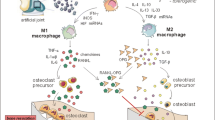Summary
The aim of the study was to assess the eventual presence, cellular localization and extent of expression of the osteoclast activating cytokine M-CSF (CSF-1) in the periprosthetic tissues around loose total hip replacement (THR). Synovial-like membrane was obtained from the implant-to-bone interface and pseudocapsule from ten total hip revisions performed for aseptic loosening and compared to ten hip synovial tissue samples obtained from ten patients who had primary THR for osteoarthritis. Avidin-biotinperoxidase complex (ABC) and alkaline phosphatase-anti-alkaline phosphatase (APAAP) methods were used for staining and VIDAS image analysis for quantification. M-CSF was mainly produced by macrophages, which often contained wear particles, but also by some fibroblasts and vascular endothelial cells. The number of cells containing (per one mm2 tissue) clearly increased in the interface (1585±212; p<0.01) and pseudocapsular (1456±248; p<0.01) tissue compared to synovial tissue (543±118). The present findings suggest, that inflammatory foreign-body type of response enhances expression of M-CSF in cases of aseptic loosening of THR. M-CSF produced in the synovial-like membrane in the implant-bone interface may contribute to activation of osteoclasts in periprosthetic bone and thus to loosening.
Similar content being viewed by others
References
Wilson WJ. Complication of hip arthroplasty. Curr Opinion Orthop 1990; 1: 44–54.
Kim KJ, Rubash HE, Wilson SC, D'Antonio J, McClain EJ. A histologic and biochemical comparison of the interface tissues in cementless and cemented hip prostheses. Clin Orthop 1993; 287: 142–52.
Goldring SR, Schiller AL, Roelke M, O'Neil CM, Harris WH. The synovial-like membrane at the bone-cement interface in loose total hip replacements and its proposed role in bone lysis. J Bone Joint Surg (Am) 1983; 65: 575–84.
Goldring SR, Jasty M, Roelke MS, Rourke CM, Bringhurst FR, Harris WH. Formation of a synovial-like membrane at the bonecement interface. Its role in bone resorption and implant loosening after total hip replacement. Arthritis Rheum 1986; 29: 836–42.
Jiranek WA, Machado M, Jasty M, Jevsevar D, Wolfe HJ, Goldring SR, Goldberg MJ, Harris WH. Production of cytokines around loosened cemented acetabular components. J Bone Joint Surg (Am) 1993; 75: 863–77.
Konttinen YT, Kurvinen H, Takagi M, Michelsson JE, Eklund KK, Nordsletten L, Buø L, Aasen AO, Santavirta S. IL-1 vs collagenase around loose total hip prostheses. Clin Exp Rheumatol 1996; 14: 255–62.
Xu JW, Konttinen YT, Waris V, Gómez-Barrena E, Sorsa T, Santavirta S. Granulocyte-macrophage colony stimulating factor in the aseptic loosening of total hip arthroplasty. J Orthop Rheumatol 1996; 9: 128–34.
Xu JW, Konttinen YT, Lassus J, Natah S, Ceponis A, Solovieva S, Aspenberg P, Santavirta S. Tumor necrosis factor-alpha (TNF-α) in loosening of total hip replacement (THR). Clin Exp Rheumatol 1996; 14: 643–8.
Konttinen YT, Xu JW, Pätiälä H, Imai S, Li TF, Goodman SB, Nordsletten L, Santavirta S. Cytokines in aseptic loosening of total hip replacement, a state characterized by a local imbalance and/or inapproriate expression of cytokines regulating osteoclasts and osteoblasts. Curr Orthop in press.
Goldring MB, Goldring SR. Basic science and pathology: Skeletal tissue resorption to cytokines. Clin Orthop 1990; 258: 245–78.
Buckwalter JA, Glmcher MJ, Cooper RR, Recker R. Bone biology. J Bone Joint Surg (Am) 1995; 77: 1256–89.
Takahashi N, Udagawa N, Akatsu T, Tanaka H, Shionome M, Suda T. Role of colony-stimulating factors in osteoclast development. J Bone Miner Res 1991; 6: 977–85.
Tanaka S, Takahashi N, Udagawa N, Tamura T, Akatsu T, Stanley RE, Kurokawa T, Suda T. Macrophage colony-stimulating factor is indispensable for both proliferation and differentiation of osteoclast progenitors. J Clin Invest 1993; 91: 257–63.
Emerson SG, Sieff CA, Wang EA, Wong GG, Clark SC, Nathan DG. Purification of fetal hematopoeitic progenitors and demonstration of recombinant multipotential colony stimulating activity. J Clin Invest 1985; 76: 1286–90.
Ikebuchi K, Clark SC, Ihle JN, Souza LM, Ogawa M. Granulocyte colony stimulating factor enhances interleukin 3 dependent proliferation of multipotential haematopoietic progenitors. Proc Natl Acad Sci USA 1988; 85: 3445–9.
Morstyn G, Burgess AW. Hemopoietic growth factors: A review. Cancer Res 1988; 48: 5624–37.
Stanley ER, Guillert LJ, Tushinski RJ, Bartelmez SH. CSF-1: A mononuclear phagocyte lineage-specific hemopoietic growth factor. J Cell Biochem 1983; 21: 151–9.
Felix R, Cecchini MG, Fleisch H. Macrophage colony stimulating factor restores in vivo bone resorption in theop/op osteopetrotic mouse. Endocrinology 1990; 127: 2592–4.
Suda T, Udagawa N, Nakamura I, Miyaura C, Takahashi N. Modulation of osteoclast differentiation by local factors. Bone 1995; 17 (2 Suppl): 87S-91S.
Mundy GR. Cytokines and growth factors in the regulation of bone remodeling. 1993; 8 (Suppl 2): S505-S510.
Jasty M, Maloney WJ, Bragdon CR, Haire T, Harris W. Histomorphological studies of the long-term skeletal responses to well fixed cemented femoral components. J Bone Joint Surg (Am) 1990; 72: 1220–9.
Santavirta S, Konttinen YT, Bergroth V, Eskola A, Tallroth K, Lindholm TS. Aggressive granulomatous lesions associated with hip arthroplasty. Immunopathological studies. J Bone Joint Surg (Am) 1990; 72: 252–8.
Santavirta S, Konttinen YT, Hoikka V, Eskola A. Immunopathological response to loose cementless acetabular components. J Bone Joint Surg (Br) 1991; 73: 38–42.
Murray DW, Rushton N. Mediators of bone resorption around implants. Clin Orthop 1992; 281: 295–304.
AL-Saffar N, Khwaja H, Kadoya Y, Revell PA. Assessment of the role of GM-CSF in the cellular transformation and the development of erosive lesions around orthopaedic implants. Am J Clin Pathol 1996; 105: 628–39.
Levack B, Revell PA, Freeman MAR. Presence of macrophages at the bone-cement interface of stable hip arthroplasty components. Acta Orthop Scand 1987; 58: 384–7.
Chiba J, Rubash HE, Kim KJ, Iwaki Y. The characterization of cytokines in the interface tissue obtained from failed cementless total hip arthroplasty with and without femoral osteolysis. Clin Orthop 1994; 300: 304–12.
Author information
Authors and Affiliations
Rights and permissions
About this article
Cite this article
Xu, J.W., Konttinen, Y.T., Waris, V. et al. Macrophage-colony stimulating factor (M-CSF) is increased in the synovial-like membrane of the periprosthetic tissues in the aseptic loosening of total hip replacement (THR). Clin Rheumatol 16, 243–248 (1997). https://doi.org/10.1007/BF02238958
Received:
Accepted:
Issue Date:
DOI: https://doi.org/10.1007/BF02238958




